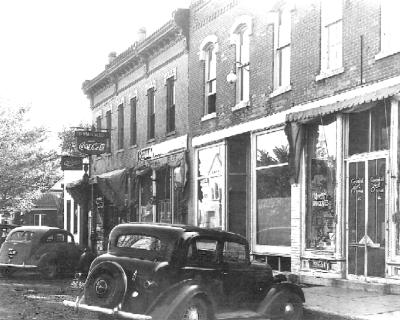
Written by Barb Kinison
The first settlement was actually at Westfield corners because that was where the stagecoach route passed through.
The first settler in the Winnebago Township was David Adams Holt in 1835.
Most of the early farmers came from New England and New York, with some coming from New Jersey, Pennsylvania and Ohio.
Roads of the time were dirt tracks, with the ‘State Road’ from Rockford to Freeport passing through the northern tier of sections of Winnebago Township.
The first school in Winnebago Township was established at Westfield in 1839.
The school house was raised in 1844 at Westfield Corners.
The organization of the Methodist church at Elida, (Winnebago), was also at Westfield corners.
Elijah Holt built the first house in 1840 and it is still standing in Winnebago Township on Montague Rd. which is now part of the Severson Dells Forest Preserve, a marker was placed there by the D.A.R. in 1981.
Most of the first land claims for that area was $1.25 an acre in the south end of the township, because it was wooded instead of prairie land.
In July of 1841, the first two purchasers of land in Winnebago Township where Henry Schoonmaker and Joseph Folsom. Mr. Folsom was a veteran of the 1812 war. Both men purchased this land from the Galena Land Office .
In July of 1846 the organization of the First Congregational Church of Winnebago met at Westfield.
In 1849 Winnebago was officially named Elida.
In 1850 there were 499 residents, most being farmers. However, Winnebago could boast 1 minister, 1 molder, 2 blacksmiths and 4 mechanics.
The Chicago & Galena Union R.R., encouraged by Chicago merchants in all the urban communities, arrived in Rockford on the east side of the Rock River in August, 1852. Each town at the west end of the line as it continued west became a magnet of growth, motivated by the massive leverage of farmers arriving with their livestock, or wagonloads of produce ready for delivery to market.
Most of the site of the future village of Winnebago was sold at $80 per acre to a group of men who then laid out where the railroad would pass.
In 1853, then the Chicago & Galena Union railroad extended to the west from Rockford to Freeport. This track forged through both Elida, (Winnebago), and Pecatonica, igniting local growth.
In October of 1854 the villages train station was laid out, and by rights was the center of attention. The depot attracted commercial development, warehouses and stockyards emerged near the tracks.
Also at this time, the Old Stone Church building was being used by the Congregational church and is now the present site of the Winnebago Cemetery.
In January 1855 Joseph D. Warner, who was the first railroad station agent, finished his house on South Elida Street.
Six months later in June, the Middle Creek Presbyterian church was built for around $2100 at Montague and Kendall Roads. By the time fall rolled around the first store was up, running, and owned by N.D. Warner, and the first school class met in the Winnebago village at the Methodist Church. Last but not least the Westfield M.E. church was having services in their own building as well. The first Physician to arrive in Winnebago was Dr. Wesley Rush Gearhart; who practiced medicine here for 30 years.
The citizens of Elida petitioned to change the villages name from Elida in favor of Winnebago.
In 1858 a frame school building was built on the southeast corner of Soper and Benton streets, a bargain at $1325.
The Edson was Winnebago’s first hotel. It was built in 1859 on the southeast corner of Benton and Main Streets, later the first public hall was added thanks to D.C. Lewis.
The Middle Creek Cemetery was established in 1859.
The year 1860 saw Winnebago township’s population at 1002.
The village itself had 276 residents, and employment ranged from physician to shoe-maker, teacher to postmaster.
In the 1860’s, it was the policy of temperance leaders not to permit alcohol establishments in the village; this was later mandated by a local option vote.
During the Civil War, Winnebago sent 150 soldiers and 2 nurses. One local mother, Mrs. Marchant, sent 10 sons for military service.
1868 saw a new 4-room school house completed at the southwest corner of S. Benton and Winnebago Streets. The First Presbyterian church was initiated in Edson Hall by the Rev. Braddock of Middle Creek church, just north across the street from the new school. Also the Free Methodist church of Winnebago was organized, and that church was built on the northwest corner of Winnebago and South Benton Streets.
In 1870, the census counted 1428 residents, these were not divided into village and rural categories because growth had now slowed.
The Winnebago High Schools first graduation class was in 1874.
1875 was the founding year for the Winnebago Farmers’ Mutual Fire Insurance Co., and the Westfield Creamery, which sent butter for judging at the Centennial Fair in Philadelphia Pa. in 1876.
In October of 1876, Local Masonic Lodge #745 of Winnebago was established.
The village was formally incorporated in 1877, the village’s population was almost 600. D.C. Lewis was elected Village President, and Reuben Alworth, clerk. First orders of business included immediately installing a windmill and stock tank on E. Soper St. followed by a local option to prohibit alcohol sales.
The organization of the Winnebago High School Alumni began in in1879.
In 1883 the Congregational church was built on S. Elida St.
The Winnebago Reflector was the village’s weekly newspaper, and it was established in1887. The Reverend Chenoweth who was the Congregational minister, started it, and its’ editor was Charles Tritle.
At the end of the 1880’s the Illinois Central railroad built its competing east-west line through the center of Winnebago Township paralleling the Chicago & Galena Union .
The offers for passenger and freight services were the same, with grain and stock loading, later grocery and gasoline outlets.
Then from 1903 thru 1930, the village was served by the Rockford & Interurban RR., an electric line with frequent passenger service from Rockford or Pecatonica and Freeport. This line also brought electrical power into Winnebago.
At this point in time laborers started commuting to work at an ever-growing Rockford, and many more residents did their shopping in Rockford rather than locally. Rides from Winnebago to Rockford were .25.
Fires obliterated the S. Benton & Main St. business buildings on one side in 1890, and then a year later destroyed the business buildings on the other side of the street. At that time property in country villages was of little value, so much of the damage was not covered by insurance. Nine years later there would be another disastrous fire downtown.
In December of 1893, the Township Hall was built with township funds and then dedicated.
In 1897 the Winnebago Produce & Supply Co. was established with local stockholders.
On August 22, 1899, the first Soldiers’ Monument was dedicated at the Winnebago Cemetery on Westfield Rd.; John M. Mitchell led in raising the $800. needed.
1903 brought telephone service to Winnebago, at first there was two competing companies, but they finally interconnected.
The Winnebago Post Office started delivery to rural routes in 1904. The two routes covered large sections of Burritt and Seward Townships as well as Winnebago.
The State Bank of Winnebago was established in its new building on the site of the Edson Hotel in 1912, it was succeeded by the People’s State Bank in the late 1920’s, and that bank fell under in 1932-33.
January 1914 The volunteer fire-fighters were organized and established in the village, and Winnebago furnished a fire engine pulled by horses in December of that year.
During this time period the churches in Winnebago dwindled from four down to two.
First Presbyterian replaced its building with a brick edifice in 1914, and The Methodist Church purchased the Congregational building and parsonage in 1920.
In August, 1925 the Winnebago Consolidated Schools’ new brick building was dedicated, this building was on S. Elida St. In 1926 the first school yearbook hand-written by the students was issued.
After WWII the population of the village started growing again. Most of the vacant lots were beginning to disappear as homes multiplied. Costs were still fairly affordable, so Veterans and wartime workers could easily provide for their expanding families.
By 1948, the State had completed the cement road through the village to U.S. 20.
In turn Winnebago expanded by putting in the water system, (1950), and sewer plant,(1958). The first zoning dictum was also a result of the village’s escalated growth.
After a handful of years, the over-crowded high school was definitely feeling the pinch, and a new building was put up at the north end of town and dedicated in 1959.
The other schools in the village followed pursuit replacing their undersized facilities.
In 1972 a volunteer library was rejuvenated by the Jr. Women’s club and in 1982 the public library district was established, the building itself was complete for use in 1988. You can find the library on N. Elida St.
Village Population Total ~ 1940-637; 1950-752; 1960-1,059; 1970-1,644; 1980-1,644; 1990-1,840; 2000-2,958; 2010-3,101
